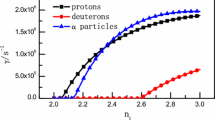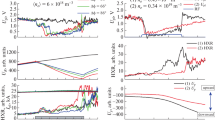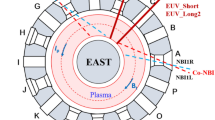Abstract
The enhancement in local and globalized electron heating has been observed after upgrading of ion Bernstien waves (IBWs) heating system in HT-7 tokamak. The overall capability of injection power has been upgraded from 350 to 600 kW (15–30 MHz) for best and active control of pressure and current density profiles, and to discover the new phenomena of plasma heating for good energy and particle confinement. A new quadruple T-type IBWs coupling antenna has been utilized which has been mounted in the toroidal direction on low field side in the device. The electron heating on both on-axis and off-axis electrons not delete has been observed. Not delete The change in direct electron heating via electron Landau damping (ELD) from IBWs has been investigated, while the bulk electron temperature showed a large rise with a heating factor, ∆(Tene)/Prf, up to 9.3 × 1019 eV m–3 kW–1 with central electron density (ne) 3.7 × 1019 m–3. The particle confinement has also been achieved with IBW injection power of 550 kW at frequency of 27 MHz and with toroidal magnetic field of 1.92 T. The modifications observed in electron temperature and other plasma profiles are discussed under various plasma conditions. The improved energy confinement has also been observed in this scenario.
Similar content being viewed by others
Avoid common mistakes on your manuscript.
INTRODUCTION
The externally launched ion Bernstein waves (IBWs) to heat tokamak plasma was firstly used in the early 1980s [1, 2]. The auxiliary heating is necessary, in most tokamak plasmas, to raise the plasma temperature for proper reactor use. The ion cyclotron range of frequency (ICRF) system is currently most developed, among the all radio frequency heating systems, and has no density restrictions on its applicability. It is successfully applied on many devices, to achieve reactor-level power. This qualifies ICRF as a prime candidate for the auxiliary heating of reactor-grade plasmas [3]. Ion Bernstein wave heating (IBWH) uses the ion Bernstein wave (IBW), a hot plasma wave, to carry the radio frequency (RF) power to heat the plasma at reactor core [4]. Ion Bernstein waves can heat ions at well-defined ion cyclotron harmonic resonance layers in the plasma or heat the electrons by localized electron Landau damping (ELD) [5].
The IBW heating is based on the phenomena that the finite Larmor radius waves in the ion ICRF frequency range excited from the low field side of machine can enter to the center of hot plasma without strong attenuation until the waves approach the harmonic cyclotron layers. The strong ion heating could be obtained when the wave passes the resonant layers, where strong ion cyclotron damping happens. Excellent IBW ion heating results have been observed on JIPPIIU, PLT, PBX and Alcator-C [6–9].
The IBW technique is attractive for tokamak plasma heating because it has good accessibility to couple the power to ion cyclotron resonant layer present at plasma core. It can be used for ion and also to heat electrons via electron Landau damping (ELD). The IBW experiments have been performed in the HT-7 tokamak with various aspects, such as heating, pressure profile, transport control, instability stabilization and also to plasma current density profile control and to enhance the confinement [10].
Both the ion and the electron heating are investigated by linear and nonlinear processes during IBW heating experiments in various devices [11]. The IBW heating phenomena was also investigated in HT-7 superconducting tokamak with deuterium plasma with an injected ICRF power up to 600 kW. The global and localized heating have been obtained by adjusting the ICRF resonance layers positions. The electron heating for both on-axis and the off-axis have been observed by optimizing the proper target plasma parameters. The direct electron heating via ELD has been observed by using IBW heating technique. The total plasma electron temperature with significant rise with this heating technique was also obtained [12, 13]. The results showed that the maximum increase in the electron temperature was above the 1 keV and the electron temperature profile was changed by IBW under various parameters and the enhancement in both energy and particle confinements have been observed [14–16].
EXPERIMENTAL SETUP
The HT-7 is a medium-sized superconducting tokamak with a limiter configuration. The movable vertical limiter and horizontal pump limiter are made of molybdenum. The major radius of HT-7 is 122 cm and the minor radius is 27.5 cm. The plasma current is about 100–220 kA, and the toroidal magnetic field is about 1.0–2.5 T. The plasma density is in a range of 0.5–5 × 1013 cm–3. The electron and the ion temperatures are about 800 and 400 eV, respectively. The main purpose of HT-7 experiments is to investigate the steady-state operation by full lower hybrid wave current drive (LHCD). The large electron temperature can be beneficial to the current driving efficiency. The electron-heating mode for IBW experiments concentrated on HT-7 to get higher electron temperature [1, 7].
The injection power capability of HT-7 ICRF heating system has been increased recently from 350 to 600 kW (15–30 MHz) for active control of current density and pressure profiles, and for better aspects of plasma heating with enhanced particle and energy confinement. A new quadruple T-type ion Bernstein waves (IBWs) coupling antenna without Faraday shielding has been utilized and mounted in the toroidal direction on low field side in the device. The heating system generator could work in short pulses, multi-pulses and continuous wave (CW) modes, to make the experiments more flexible.
The ICRF system for HT-7 includes a RF generator, transmission lines, three liquid stub tuners and antennas. The IBW antenna locates at the equatorial plane in the low field side of the tokamak. The new and old IBW antennas of HT-7 are shown in Fig. 1. The central conductor is made of stainless steel having radius of 32 cm. The maximum RF power of generator is now 600 kW. Three liquid stub-tuners are used to match the impedance of the antenna. Deuterium is adopted as the working gas with the minority of hydrogen. The ΩH layer is located at the central region of the Plasma or the off-axis location by choosing proper toroida1 magnetic fie1ds.
RESULTS AND DISCUSSIONS
Experiments have been performed to investigate Electron heating in deuterium plasma during IBW plasma heating in the HT-7 superconducting tokamak. A new high power asymmetric quadruple T-type antenna has been installed and used with a central feeder and short ends. The orientation of the antenna is in the toroidal direction. The n|| spectra are peaked at 8, 9, 10 at the 30, 27, and 24 MHz frequency, respectively.
At the 24 MHz, when BT was 2.0 T, the 2ΩD resonance layer was located at the center and the 5ΩD/2 layer was near the plasma edge at low field side. Under these experimental conditions, the significant improvement in particle confinement, improvement in energy confinement and the peaked density profile were observed during the IBW heating. Both particle and energy confinement were improved by a factor of 3 and 1.5, respectively.
Various self-explanatory signals are shown from HT-7 shot # 94 438 in Fig. 2. The first signal from top contains plasma current and loop voltage. The second signal from top contains electron density. The third signal from top contains IBW power and Halpha. Fourth signal from top contains ECE data at different positions. Fifth signal from top contains soft x-rays and ultra violet.
The electron cyclotron diagnostic system has been employed to measure the electron temperature as shown in last signal from top. The electron and ion temperatures before IBW injection has been 0.4 and 0.2 keV, respectively. At the IBW power of 320 kW, electron and ion temperature increased up to 0.8 and 0.4 keV, respectively. At the IBW power lower than 120 kW, no improvement in heating and confinement was observed.
At the 27 MHz, the resonant layer of 2ΩD located inside the plasma. The global and the localized electron heating were obtained at different 2ΩD resonant layer positions. At this frequency of IBW heating the ion cyclotron layers are more heated as compared to other used frequencies so it can be used to optimize the electron temperature and pressure profile of the plasma.
The data from ECE diagnostic from different channels has been used to measure electron temperature. A multi-channel far-infrared (FIR) hydrogen cyanide (HCN) laser interferometer has been utilized to measure electron density profiles. Impurity problem was not observed on boronization wall even at IBW power up to 550 kW.
At the change of 2ΩD resonant layer position from 5 to 15 cm (BT was changed from 2.0 to 1.88 T), the both on-axis and the off-axis heating effect was measured. For on-axis case, very broad ne profile was observed at 0.30, 0.34, and 0.36 s of the signal as shown in Fig. 3 but no serious broadening was observed in off axis case. However, the global electron heating was observed for on axis case and for off-axis case, the localized heating was obtained as shown in Fig. 4 recorded at 0.30, 0.34, and 0.36 s of the signal.
The observed electron heating was at its best and the electron temperature rose to about 0.8 keV at the IBW power of 320 kW. The graph shows that the electron temperature is peaked at 0.34 s of the signal at about 2 cm from core of plasma at low field side. At this point, when the electron temperature rise, the τE and τP increased in both on-axis and off-axis heating modes. The observed improved confinement in the off-axis heating mode was better than that in the on-axis heating mode. The variation of heating factor electron with density is shown in Fig. 5 and the variations of heating factor with IBW input power is shown in Fig. 6.
When working with 30 MHz IBW heating, the 3ΩD resonant layer was not obtained inside the plasma and the 2ΩD resonant layer was found near the edge of plasma at the high field side. The observed electron heating was at its lowest at the IBW power of 350 kW and serious change in density profile was not observed. The improvement in particle and energy confinement was also not observed even at the IBW power was increased up to 550 kW.
CONCLUSIONS
The IBW heating was thoroughly carried out in experiment and the rise in electron-heating mode was observed after the RF boronization and the helium cleaning of the vessel. The electron heating in both the on-axis and the off-axis were observed by changing the proper target plasma parameters. The maximum increase in electron temperature was observed as 0.8 keV at the maximum input RF power at 320 kW. The large increase in electron temperature and the low rise of ion temperature gave the evidence that the rise in electron heating was observed due to electron Laundau damping.
The rise in both the electron and the ion temperature were investigated and improvement in τE and τP were observed by using the 1BW at 24 and 27 MHz frequencies. It has been observed that the electron temperature and the pressure profile can be optimized by controlling the ion cyclotron resonant layers and the IBW at 27 MHz. The large density variation was not found during the IBW heating at 24 MHz, while only the electron heating was observed during IBW heating experiment at 24 MHz and no heating and confinement effects was observed in 30 MHz case.
REFERENCES
Moody, J.D., Porkolab, M., Fiore, C.L., McDermott, F.S., Takase, Y., Terry, J., and Wolfe, S.M., Phys. Rev. Lett., 1988, vol. 60, p. 1101.
Zhao Yanping, Plasma Sci. Technol., 2006, vol. 8, no. 1, p. 33.
Noterdaeme, J.-M. and Van Oost, G., Plasma Phys. Controlled Fusion, 1993, vol. 35, p. 1481.
Li, J., Zhao, Y.P., Wan, B.N., Zhao, J.Y., Watari, T., and Seki, T., J. Nucl. Mater., 2003, vols. 313–316, p. 1188.
Baonian Wan, et al., Phys. Plasmas, 2003, vol. 10, no. 9, p. 3703.
Qin Chengming, et al., Plasma Sci. Technol., 2005, vol. 7, no. 5, p. 3002.
Ono, M., Phys. Fluids, 1993, vol. 5, p. 241.
Zhao, Y.P., Plasma Phys. Controlled Fusion, 2001, vol. 43, p. 343.
Li, J., Plasma Phys. Controlled Fusion, 2001, vol. 43, p. 1227.
Li, J., et al., Phys. Plasmas, 2003, vol. 10, no. 5, p. 1653.
Ono, M., Watari, T., and Ando, R., Phys. Rev. Lett., 1985, vol. 54, p. 2339.
Ogawa, Y., Kawahata, K., and Ando, R., Nucl. Fusion, 1987, vol. 27, p. 1379.
Seki, T., Kumazawa, R., and Watari, T., Nucl. Fusion, 1992, vol. 32, p. 2189.
Ono, M., Beiersdorfer, P., and Bell, R., Phys. Rev. Lett., 1988, vol. 60, p. 294.
Jiang, T.W. and Ona, M., Bull. Am. Phys. Soc., 1990, vol. 35, p. 1954.
Takase, Y., Moody, J.D., and Fiore, C.L., Phys. Rev. Lett., 1987, vol. 59, p. 1201.
Author information
Authors and Affiliations
Corresponding author
Rights and permissions
About this article
Cite this article
Sajjad, S., Gao, X. Plasma Profiles Modifications by Upgraded Power of IBW Heating System in HT-7 Tokamak. Instrum Exp Tech 63, 695–698 (2020). https://doi.org/10.1134/S0020441220050048
Received:
Revised:
Accepted:
Published:
Issue Date:
DOI: https://doi.org/10.1134/S0020441220050048










